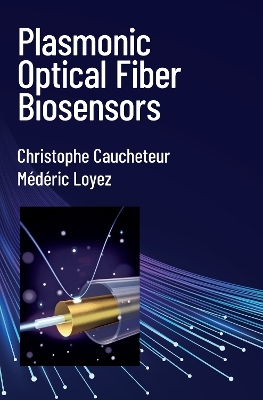
Plasmonic Optical Fiber Biosensors
Artech House Publishers (Verlag)
978-1-63081-971-2 (ISBN)
You will learn about the role of the fiber configuration and the functional coating on the properties of the resulting optrodes. You will also get an encompassing overview on all optical fiber configurations used for plasmonic sensing thus far, especially on the progress made over the last decade and rendering the technology compatible for use in real conditions. The book presents both fundamental aspects and advanced applications while focusing on recent and emerging fields of research, such as the use of tilted fiber Bragg gratings, the integration of sensors in situ, the use of smart interrogation techniques, and much more.
This is a unique reference for both beginners and experts in optical fiber-based sensors, especially for industrial engineers working in biophotonics and biochemical sensing, as it presents state-of-the-art design procedures and sensing features. The book’s theoretical background combined with recent advances of plasmonic-based optical fiber technologies also make it highly beneficial for all researchers, academics, and students specialized or interested in this flourishing and promising discipline.
Chapter 1 (Introduction)
Rationale – Optical fibers Vs. Krestschmann prism
Positioning of the book content
Content review
Practical considerations
Chapter 2 (Physical concepts on surface plasmon sensing)
2.1. Mathematical formalism
2.1.1. Maxwell equations
2.1.2. Constitutive equations
2.1.3. Boundary conditions
2.1.4. Wave equations
2.1.5. Plasmons at a single interface
2.2. Excitation of surface plasmons
2.3. Long-range surface plasmons
2.4. Prism configurations & optical fiber counterpart
2.5. Localized surface plasmons
2.6. Plasmonic materials
2.7. Signal analysis and performance indicators
2.7.1. Signal analysis
2.7.2. Performance indicators
2.8. References
Chapter 3 (Multimode optical fiber plarforms)
3.1. Light propagation in optical fibers
3.1.1. Geometrical approach
3.1.2. Electromagnetism approach
3.2. Overview of multimode optical fibers
3.3. Unclad or etched configurations
3.4. Tapered configurations
3.5. D-shaped configurations
3.6. U-bent configurations
3.7. Interferometers – Hetero-core structures
3.8. Fiber end facets
3.9. References
Chapter 4 (Single-mode optical fiber platforms)
4.1. Overview of single-mode optical fibers
4.2. Etched, tapered and D-shaped configurations
4.3. Thinned uniform fiber Bragg grating configurations
4.3.1. Basics on uniform fiber Bragg gratings
4.3.2. Temperature sensitivity of uniform FBGs
4.3.3. Axial strain sensitivity of uniform FBGs
4.3.4. Pressure sensitivity of uniform FBGs
4.3.5. Transverse strain sensitivity of uniform FBGs
4.3.6. Refractometric sensitivity of uniform FBGs
4.4. Weakly and highly tilted fiber Bragg gratings
4.4.1. Weakly tilted fiber Bragg gratings
4.4.2. Excessively tilted fiber Bragg gratings
4.5. Eccentric fiber Bragg gratings
4.6. Long period fiber gratings
4.7. References
Chapter 5 (Specialty optical fiber platforms)
5.1. Polarization-maintaining optical fibers
5.1.1. Introduction to the concept of polarization-maintaining optical fibers
5.1.2. Use of polarization-maintaining optical fibers for plasmonic excitation
5.2. Microstructured optical fibers
5.3. Polymer optical fibers
5.4. Bioresorbable optical fibers
5.5. Fibers incorporated with metal nanoparticles
5.6. References
Chapter 6 (Immunosensors)
6.1. Introduction to biochemical sensors
6.2. Antibodies
6.3. Nanobodies
6.4. Affimers
6.5. Application of immunosensors
6.5.1. Immobilization strategies
6.5.2. Immunosensors
6.5.2.1. Protein detection
6.5.2.2. Virus and cell detection
6.5.2.3. Critical review
6.5.3. SPR Signal analysis
6.6. Conclusion
6.7. References
Chapter 7 (Nucleic acid-based receptors (DNA and RNA))
7.1. DNA receptors
7.1.1 Binding DNA receptors on glass
7.1.2. Binding DNA receptors on plastic
7.1.3. Binding DNA receptors on metals
7.1.4. Binding DNA receptors on polymeric materials
7.1.5. DNA spot arrays and microstructures
7.1.6. Design and synthesis of specific DNA 2D/3D structures
7.2. RNA/miRNA receptors
7.3. Aptamers
7.4. Applications of nucleic acid-based biosensors
7.4.1. Hybridization / complementary strand detection
7.4.2. Protein, toxin, and organic compound detection
7.4.3. Cell detection
7.4.4. Ion detection
7.5. Conclusion
7.6. References
Chapter 8 (Other bioreceptors for plasmonic biosensors)
8.1. Molecularly imprinted polymers (MIPs)
8.2. Enzymes
8.2.1. Enzymatic biosensors
8.2.2. Glucose biosensors
8.2.3. Snapshot on other enzymatic biosensors
8.2.4. The case of ELISA
8.2.5. Immobilization of enzymes on different substrates
8.2.6. Optical fiber-based enzymatic biosensors
8.3. Proteins
8.3.1. Anchor proteins (A, G, L)
8.3.2. Protein/antibodies or protein/protein interactions
8.4. Cells
8.5. Additional layers and matrices
8.5.1. Hydrogels
8.5.2. Dextran matrices
8.6. Optical fiber-based applications
8.7. References
Chapter 9 (Combined plasmonic sensors)
9.1. Electro-plasmonics
9.1.1. Voltammetry
9.1.2. Conductometry
9.1.3. Amperometry
9.1.4. Potentiometry
9.1.5. Combination with plasmonic optical fiber sensing
9.2. Magneto-plasmonics
9.3. Fluorescence-based and quantum dots-based plasmonics
9.4. Raman scattering
9.5. Ultrasound and radio-plasmonics
9.6. References
Chapter 10 (Current developments and future challenges)
10.1. Integrated optical fiber devices
10.1.1 Microfluidics
10.1.2. Optofluidics
10.1.3. Smartphone-based OF sensors
10.1.4. Multiplexing
10.2. Towards commercial practices
10.3. Point-of-care sensing and related innovation
10.4. Towards in situ sensing
10.5. Artificial intelligence (AI)-assisted sensing
10.6. From sensing to imaging
10.7. References
Chapter 11 (conclusion)
| Erscheinungsdatum | 17.05.2023 |
|---|---|
| Verlagsort | Norwood |
| Sprache | englisch |
| Maße | 178 x 254 mm |
| Themenwelt | Technik ► Elektrotechnik / Energietechnik |
| ISBN-10 | 1-63081-971-9 / 1630819719 |
| ISBN-13 | 978-1-63081-971-2 / 9781630819712 |
| Zustand | Neuware |
| Haben Sie eine Frage zum Produkt? |
aus dem Bereich


